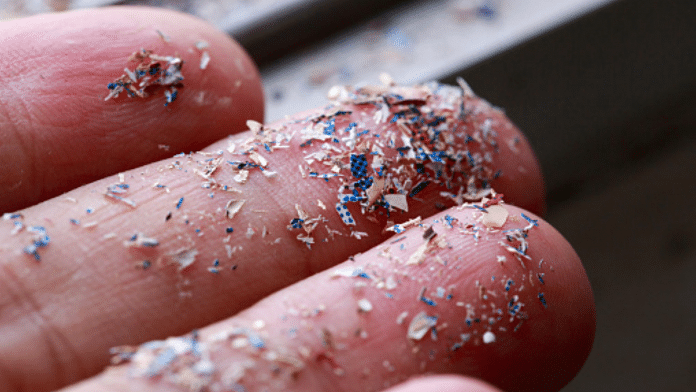Microplastics, tiny particles less than 5mm in size, are everywhere – including in our bodies. In 2018, they were first detected in human faeces. In March 2022, they were also found in human lungs and blood. They enter our bodies through the food we eat, the water we drink and even the air we breathe. As they accumulate over time, there is plenty of reason to worry about the possible effects on our health.
Why are microplastics everywhere?
Between 1950 and 2020, annual plastic production grew from 1.5 million metric tonnes to 367 million metric tonnes. Cumulatively, global production exceeds 8 billion metric tonnes. This includes plastic for packaging (36%), construction (16%) and textile manufacturing (14%).
Plastic is convenient, versatile, and cheap, but the enormous volume produced vastly exceeds our capacity to treat plastic waste safely, particularly in developing countries, owing to illegal dumping and a lack of adequate waste management systems. At present, just 9% of used plastic is recycled as not all kinds of plastic can be recycled. About 20% is burnt, which causes a host of health issues depending on the performance and safety of burning methods used, ranging from open fires to incinerators. The remaining 70% ends up in landfills and dumpsites or as litter on sidewalks, in rivers, forests, and oceans.
According to analysis from 2021, 81% of the world’s plastic enters our oceans from Asia. South-East Asia, for example, is a major contributor to land-based plastic waste leaking into the world’s oceans, with 6 of 10 ASEAN member states generating a combined 31 million tonnes of plastic waste annually. Once it enters the environment, plastic is difficult to clean up. It is durable and gets easily enmeshed in its surroundings. It remains in the environment for more than 500 years, breaking down slowly into microplastics that almost move freely through water and air. Plastic is then ingested by humans, fish, turtles or birds and at times animals get entangled in it and die.
How to respond to the plastic waste crisis
The plastic crisis calls for sustained and collective efforts to do things differently to eventually create a zero-waste circular economy. Given that plastic production significantly exceeds treatment capacities, it is crucial to drastically reduce both its production and use. Measures should primarily target single-use plastics such as bags, straws, and packaging, which are thrown away immediately after use. Single-use plastics are useful for mere minutes, but their negative effects last for decades or centuries.
Regulatory measures, as well as financial incentives and disincentives, have been applied to reduce the production of single-use plastics and expedite innovative solutions, such as switching from single-use to multiple-use plastics and sustainable alternatives and designing products that are easily recyclable. To date, more than 127 countries introduced regulatory measures including bans, taxes, and levies against single-use plastic. Governments in Cambodia, Malaysia, the Philippines and Thailand have adopted circular economy strategies to prioritize plastics-related policies and investments.
Unquestionably, good governance is part of the solution, but cooperation and support from businesses and consumers must follow suit. Across the globe, awareness and information campaigns are aimed at behavioural changes, such as the adoption of sustainable consumption and the promotion of recycling and plastic alternatives.
The Plastic Waste Perceptions Survey of 2,000 consumers and 400 food and beverage businesses in Indonesia, Malaysia, the Philippines, Thailand and Vietnam, conducted by the United Nations Environmental Programme (UNEP) and the Food Industry Asia (FIA) in 2020, found that 91% of consumers are “extremely concerned” about plastic waste. But more than half of the consumers surveyed continue to use non-recycled containers, owing to cultural norms and a lack of awareness about reusables or alternatives.
Yet, such campaigns cannot completely solve the problem. This leaves a heavy burden of responsibility on oil and plastic producers. According to the Minderoo Foundation’s plastic waste makers index, 20 companies, including ExxonMobil, Dow and Sinopec, are producing virgin polymers used for 55% of global single-use plastic. Furthermore, a citizen-led plastic brand audit conducted in 45 countries in 2021 flagged global brands including Coca-Cola, PepsiCo, Unilever and Nestle in terms of the quantity of plastic waste found at clean-ups.
One strategy for involving producers in seeking solutions is the introduction of the Extended Producer Responsibility (EPR) policy tool, which makes producers responsible for the collection, recycling and treatment of post-consumer products. More than 60 countries have already adopted such policies. Policy discussions on the potential value and feasibility of EPR-based regulations are ongoing in several East and South-East Asian countries. In addition to China, Thailand and India, Vietnam, Malaysia, Indonesia and Cambodia are also considering the introduction of EPR. This shift to a circular economy and promoting innovation can be hastened by impact investment and innovative finance. Corporate, and financial institutions are, therefore, important agents for change.
Now is the time to take local and global actions for transformational changes to reduce plastic dependency and ensure a safe and sustainable planet, for our health, survival and prosperity.
Alissar Chaker is Resident Representative, United Nations Development Programme in Cambodia
Moeko Saito Jensen is Environment Policy Specialist, United Nations Development Programme in Cambodia
The article originally appeared in the World Economic Forum.
Also read: Unsustainable logging, hunting — new report finds what’s driving a million species to extinction



